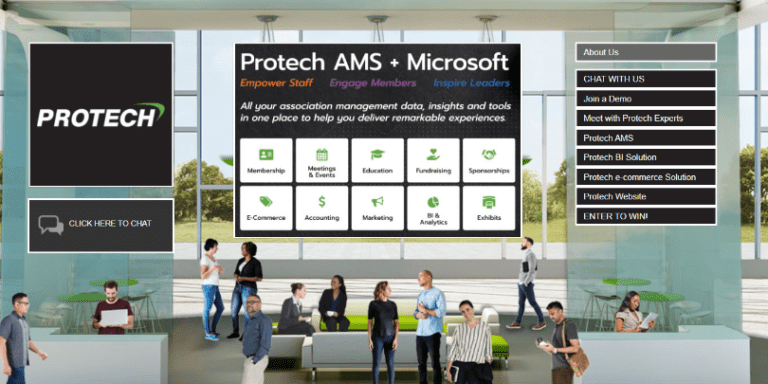
By Liz Palm, Marketing Director
At ASAE’s Virtual Annual Meeting & Expo, there was a lot of talk about the what the “new normal” will look like post COVID-19. For many associations, the new normal includes a remote and flexible work environment for their staff, with an in-depth virtual event and professional development strategy for their members.
These new concepts were the main topics of discussion in Protech’s webinar with technology experts from Association Analytics, Guidebook and Higher Logic.
In Part 1 of this series, How Associations Are Reimagining Event Experiences, we touched on the importance of mobile apps and online communities for the future of events. Below are a few more trends in the virtual association industry that will undoubtedly have an impact on your team for years to come.
Transforming Association Revenue Models
The traditional revenue model for associations – one that primarily relied on an annual meeting or conference to support their operational budget – is no longer sustainable. Virtual events, and the data analytics that come with it, are changing that for the better.
According to Greg Pollack, VP of Sales at Association Analytics, the new model looks more like this: One person consumes content (the event attendee), one person creates content (the thought leader or industry expert), and a third person pays for the two to meet in some capacity (sponsor).
Look no further for this type of model than the record-breaking event experience at ASAE’s 2020 virtual Annual Meeting & Expo. With over 13,000 attendees, ASAE’s industry partners financially supported the event so that members could join for free and meet with a variety of thought leaders who shared their experiences working with members at nonprofits.
Think about it another way: When you log in to LinkedIn, YouTube, Instagram or any of the other countless apps you use daily, you are not paying for the content you consume. A thought leader or popular influencer is using the platform to share and promote content organically that eventually leads to some sale down the line. And advertisers are paying the social media platform to place the ad in front of a targeted group of users, ultimately covering the costs for the social media company.
Greg Pollack gave this advice for association managers who are planning events for 2021:
“Let’s not think of our event in a vacuum – if we get twice as many people to attend, that engagement causes them to be more aligned and associated with our organization, and that causes an increase in renewals. So what if we lost money in our event? We made money in other places: sold more books, got more renewals, had more people attending other things throughout the year.”
By putting your event in a vacuum separate from your other programs, memberships and non-dues revenue streams, you ignore the positive impact it has on those programs and revenue streams.
This model is more reliable, sustainable and can easily be standardized across all program activities within your association. Would you be willing to try it?
Changing Value Propositions
With changing revenue models come changing value propositions, so be sure to keep in mind how attendees perceive the value of your event. Does this new model devalue the credibility of the content in any way? Have the value points changed since you are delivering and paying for the event in new ways? Does the commitment level of the attendee drop since there is no loss for them if they miss the event – especially if they can access the content on-demand?
In response to some of these concerns, we have seen industry leaders set a deadline for post-event content access. Following ASAE’s Marketing, Membership & Communications conference this year, content was only accessible for 30 days after the event.
Keep in mind, the number of in-person attendees will likely go down in hybrid environments, but that’s not necessarily bad. Fewer in-person attendees will mean lower costs to hold in-person events. And, you will have opportunity to add attendees to the virtual component or add more virtual events throughout the year for little to no additional cost.
Don’t let budget be the sole driver when designing the event. Instead, design the event to fit the needs of your members and evaluate systems based on that criteria.
What’s Next for Associations?
It can be difficult to fully grasp all the emerging trends within the association industry right now, especially as many of us are still adapting and getting comfortable in remote work environments. But these are also exciting times for associations to reimagine their non-dues revenue models and event experiences because there is a collective consensus that associations don’t have to solely rely on an annual meeting or conference to support their operational budget. Instead, they can host more virtual events for more personalized engagement with specific membership groups.
Perhaps the “new normal” will not fully materialize for a couple years. But it’s already clear that the associations that efficiently and quickly acclimate themselves to the current changes will survive and set themselves up for long-term success.
For a more in-depth discussion on the emerging association trends following ASAE 2020, download our webinar – ASAE Annual Roundtable: How Virtual Meetings in 2020 are Reshaping the Future of Events
